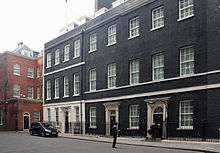Cabinet Office Briefing Room
|
Released in 2010 under the Freedom of Information Act 2000, this is the only publicly available photo of the classified COBR facility. | |
| Location | London |
|---|---|
| Country | United Kingdom |
| Purpose | Crisis management centre |
Cabinet Office Briefing Rooms (COBR, often referred to as COBRA)[1][2] are the locations for a type of crisis response committee set up to co-ordinate the actions of bodies within the Government of the United Kingdom in response to instances of national or regional crisis, or during events abroad with major implications for Britain. The composition of a COBR meeting depends on the nature of the incident but it is usually chaired by the Prime Minister or another senior minister, with other key ministers as appropriate, and representatives of relevant external organisations such as the Association of Chief Police Officers and the Local Government Association.[2][3]
COBR meetings are generally held in one of the Cabinet Office buildings in Whitehall, London. Each is held in a secure room fitted with video and audio links able to display all intelligence information relevant to the situation under discussion. Unlike the equivalent US facility, the White House Situation Room, it is only staffed during each period of use. It is on the first floor of the building and not below ground or hardened against attack.
The term COBRA (or Cobra) often used by news media is the acronym for Cabinet Office Briefing Room A, as the meetings were usually held in Conference Room A[4] at the Cabinet Office main building at 70 Whitehall. This abbreviation is no longer used within the Cabinet Office. Official papers bear a logo based on that of the Cabinet Office with the addition of the words "Briefing Rooms".[5][6] In 2009, former senior police officer Andy Hayman, who sat on the committee after the 7 July 2005 London bombings and at other intervals from 2005 to 2007, was highly critical of its workings in his book The Terrorist Hunters.[7]
A single photo of COBR was released in 2010 in response to a Freedom of Information Act request.[8]
The first Cobra meeting took place in the 1970s to oversee the government's response to the 1972 miners' strike.[9] Other events that have led to meetings convening include the 1980 Iranian Embassy siege, fuel protests, the 2001 foot and mouth outbreak, the 11 September 2001 attacks, the 7 July 2005 London Bombings, the murder of Lee Rigby,[10][11] the 2015 Sousse attacks, the refugee crisis in Calais,[12] the 2015 Paris attacks and after the 2016 Brussels bombings.
In popular media
- COBRA was featured in the fifth Alex Rider novel, Scorpia. Alan Blunt, the director of MI6, takes Alex to a COBRA meeting to figure out what Invisible Sword (a proposed high-scale terrorist attack) is and how to stop it.
- It was also mentioned in the Frederick Forsyth novel The Fourth Protocol, in which a group of high-ranking government officials from the UK discussed the leakage of classified documents which were passed from a Defense Ministry employee to the Soviets.
- COBRA was mentioned in the Andy McNab novel Fortress.
- The disaster film Flood (2007) introduces COBRA as "New Scotland Yard – COBRA Division" and spends much time following the fictional commissioner as she attempts to deal with the growing crisis in London. When they have to relocate due to Whitehall being threatened, the resulting location is introduced as COBRA 2.
See also
- Civil Contingencies Committee
- White House Situation Room – the United States version
References
- ↑ Emergency Response – Central Government Arrangements – cabinetoffice.gov.uk
- 1 2 Emergencies: the legal and operational framework – cabinetoffice.gov.uk
- ↑ Gardiner, Joey (21 October 2002). "What is Cobra". The Guardian. London. Retrieved 15 September 2009.
- ↑ "Key facts about COBR(A)". 7 September 2007. Retrieved 31 July 2012.
- ↑ Brian Brady (25 March 2007). "Blair convenes Cobra team as crisis in Iran escalates". Scotland on Sunday. Retrieved 28 April 2009.
- ↑ Sir Gus O'Donnell, Cabinet Secretary, interviewed on BBC TV programme The Secret World of Whitehall, 2011
- ↑ O'Neil, Sean (22 June 2009). "Cobra emergency committee 'slows everything down'". The Times. London. Retrieved 3 January 2010.
- ↑ "COBR – a Freedom of Information request to Cabinet Office". WhatDoTheyKnow.
- ↑ "File 9: Central Government in War in the 1980s".
- ↑ "London 2012: What exactly is a Cobra meeting?". BBC News.
- ↑ "Cobra meeting hears 'strong indications' machete murder was a terrorist attack". ITV News.
- ↑ "Britain calls emergency meeting on Calais migrants". Deutsche Welle. Berlin. AFP. 31 July 2015. Retrieved 31 July 2015.

